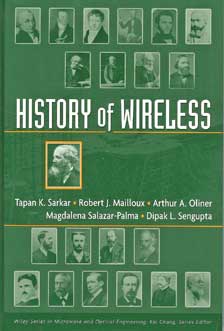 History
of Wireless
History
of Wireless
By T. K. Sarkar, R. J. Mailloux, A. A. Oliner, M. Salazar-Palma,
and D. L. Sengupta (with contributions from another fourteen authors)
JohnWiley & Sons, 2006
(675 pages)
The Preface of this book starts by quoting A. Comte: “One
does not know completely a science as long as one does not know
its history.” Several other interesting quotations are given,
from which one may be highlighted due to N. Webster: “History
is a narrative of events in the order in which they happened with
their causes and effects. A narrative (story) is very different
from an annal (a summary listing of dates, events, and definitions).
Narrative stories should be used for teaching history if the student
is to gain any understanding. Annals are best used for a summary
review by one who has already learned the stories as annals summaries
relate the facts and events of each year, in direct chronological
order, … ”
In this 675-page book, the authors have followed the two paths
suggested by Webster. The first two chapters provide the annals
of wireless, whereas the remaining chapters are narratives of
its history. The reason for using the word “Wireless”
can be found in the explanation given by J. D. Kraus and R. J.
Marhefka: “After Heinrich Hertz first demonstrated radiation
from antennas, it was called wireless. And wireless it was until
broadcasting began around 1920 and the word radio was introduced.
Now wireless is back to describe the many systems that operate
without wires …”
This is a book written by a total of nineteen wireless specialists
who are working in that field and are writing its history. After
the chronology of the developments in magnetism, electricity (including
some unknown facts like the Baghdad battery, dated 250 BC) and
light, up to the time of J. C. Maxwell, the first chapter focuses
on Maxwell and gives a lively account of who he was and what he
actually did. Through the pages of this chapter the reader will
discover that even if Maxwell had not contributed to electromagnetics
(the physical basis of wireless) as he did, he would still have
been one of the greatest scientists of the world: he contributed
to optics and ophthalmology, to astronomy, to the kinetic theory
of gases - laying the ground work for statistical mechanics, to
establishing the modern set of units, to negative feedback, to
control systems, to the theory of heat, to topology, etc. His
work even helped the creation of information theory. The first
chapter ends with an excellent explanation of Maxwell’s
contributions to electromagnetic theory, which should be of special
interest to the members of the EMC Society.
In the second chapter, together with the work of other well-known
pioneers in electromagnetics, the reader will discover the contributions
of unknown individuals like Nathan B. Stubblefield (who transmitted
human voice without wires in 1882 and was granted several patents
for it!), Antonio Meucci, and so on. The fascinating controversy
about the discoverer of radio (was it G. Marconi, J. C. Bose,
N. Tesla, A. S. Popov, R. A. Fessenden, or any other?) is presented
through facts and dates. The chronology goes up to 1990, since
to write history one needs to keep some distance on time.
The next three chapters describe in detail the evolution of Continental
Europe and British electromagnetics ending with Maxwell, the genesis
of his equations, and how his followers redeveloped Maxwell’s
theory and made it understandable to a broader audience. It is
interesting to note that the four equations that we use today
were not originally developed by Maxwell, but by H. R. Hertz and
T. Heaviside.
The next five chapters are devoted to the history of Heaviside’s
work, the scientific accomplishments in wireless before Marconi,
the fascinating history of Tesla (who holds the first patent for
radio in the US), the astonishing millimeter-wave wireless experiments
of Bose in Kolkata, India (which included its generation, the
development of horn antennas, circular waveguides, and a number
of artifacts still in use), and, finally, J. A. Fleming’s
contributions to wireless.
The reader will also learn in the next chapter about the many
contributions of German scientists, including Hertz, K. F. Braun,
R. von Lieben, H. Barkhausen, and others not so well known.
Chapter 12 is really interesting. The authors focus on the technologies
used during the first decade of the twentieth century for wireless
telegraphy and telephony communications, and to give credit where
credit is due, with emphasis on long distance (transatlantic)
communications, making the case for R. A. Fessenden.
The next three chapters offer the reader new and interesting facts
related to the history in South Africa, Japan, and the Soviet
Union about wireless communications, antennas, and quasi-optics
wavelengths, etc.
Finally, Chapters 16 and 17 deal with the evolution of waveguides
and phased array antennas, this last topic being extremely close
to the state-of-the-art in wireless technology today, where one
of the fundamental topics is space diversity.
In summary, History of Wireless is an interesting and thorough
account of how the various components and wireless systems evolved
and their authors. It is a valuable book for a broad scientific
audience and, in particular, for those scientists and engineers
in the field.
This book on the history of wireless is especially timely on the
occasion of the 50th Anniversary of the EMC Society and the review
of its history based on the work of Maxwell. EMC
(Note: Some of this material will be interspersed in the Plenary
and History Sessions at the 2007 IEEE International Symposium
on EMC. In particular, Dr. Sarkar will provide a presentation
on Maxwell and his contributions to the science of EMC during
the Plenary Session at the symposium.)
 Book
Review
Book
Review